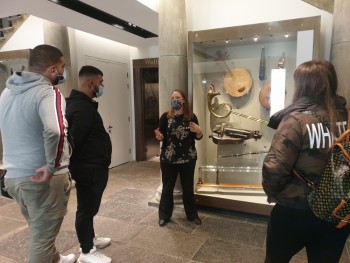Between March 2021 and March 2022, the Equality, Diversity & Inclusion in Scottish Heritage (EDISH) Project delivered a collaborative programme of engagement with Scottish heritage organisations around Equality, Diversity and Inclusion (EDI).
Funded by the AHRC, the 12-month EDISH project was designed was designed to explore EDI barriers within Scotland’s heritage organisations. Lead by Strathclyde University and Museum Galleries Scotland (and supported by the Society of Antiquaries of Scotland) the project activities included data collection, the creation of resources to support BAME-focuses community heritage project and funded EDI-focuses workplace placements. CIfA was approached by the Society of Antiquaries of Scotland to support the delivery of work-based placements with an archaeology focus.

Placement design
Drawing on our collective experience and learning from similar initiatives, we were determined to remove as many barriers as we could to participating in this placement scheme. Crucially, these placements were paid positions, enabling participants to learn and not loose income elsewhere.
We also avoided an open call for participants, we decided early on to work directly with one organisation who had an establish youth audience to ensure participants had peer to peer support. This would hopefully reduce the potential for feeling isolated and disconnected during the placement. We were fortunate that Ando Glaso, (a third sector organisation which promotes Roma Culture in Scotland) had capacity to work with us.
We made the placement flexible – eschewing the 9 to 5 / 5 days a week structure, designing the programme around their schedules. We worked with them directly two days in the week and had a shared google drive to support work out of direct contact time. We ensured that outputs were co-designed with the placements (once in post) – for example the end of placement report could be a video or a public talk rather than a written document.
Through our individual contacts within Scottish archaeology, we created a varied programme of experiences. We had to take a hybrid approach to delivery due to capacity and COVID. However, this approach resulted in broadening the range of heritage professionals the participants were able to work with. With that flexibility, we created a programme of experiences which emphasised the variety of job roles within the profession.
Key activities
CIfA supported the delivery of thirteen sessions took place over four months. Taking a hybrid approach to delivery ensured that the placements were offered a diverse range of experience. The placements included day visits to museums (St Celia’s Music Hall, The Huntarian Museum), university departments (Glasgow University Archaeology Department, Strathclyde University), visitor attractions (Edinburgh Castle) and the Museum Galleries Scotland office.
Online activities including meeting online with heritage professionals from (Archaeology Scotland, Society of Antiquaries of Scotland, Chartered Institute for Archaeologists) and discussed in careers and career paths in archaeology and heritage. These sessions also gave participants give feedback on strategic work currently taking place (as part of Scotland’s Archaeology Strategy) which aims to increase different entry routes into careers in archaeology.
The participants highlighted at the start of the placements, that they would like to gain experience with presentation experience. This was incorporated within the placement.
In March 2022, the project team took part in an end of project seminar (hosted by MGS) to share key learning points on the placement. The recording of that event can be accessed here. CIfA’s reflections on the placement design were also shared at the 2022 CIfA conference.
Key learning points
The project allowed the participants to give their thoughts on archaeology careers, thoughts which included
- Amazed at the variety of careers which are available with heritage careers
- Importance of reaching young people through schools
- It is a crowded careers market and all have highlighted how archaeology needs to stand out in that career market
- Importance of different entry routes into archaeology careers (and different ways of learning) - would attract different audiences
- Importance of reaching young people through schools (and utilise the ‘school trip’ to our advantage)
- We should really 'sell' the experience of what it is to be an archaeologist (and learn to market it differently)
- Using a variety of mediums to promote careers in archaeology are the most effective way forward (video mixed with presentations for example)
- Local archaeology ambassadors would be a great thing to do - local archaeologists going into schools & youth groups to talk about job roles
Acknowledgements
The project could not have taken place without Blanka, Laura, Leon and Lubo who took part in the placement opportunities, and to Janos Lang from Ando Glaso who supported the development of the project.
The EDISH project was delivered by Dr Devon McHugh (MGS), Dr Churnjeet Mahn and Dr Nathar Iqbal (Strathclyde University) and Dr Jeff Sanders from the Society of Ant


